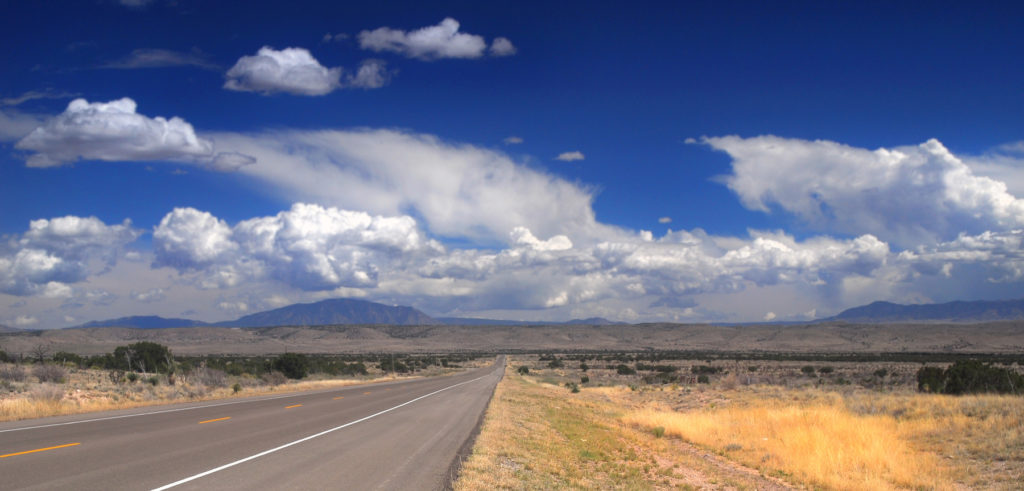The History of State Roads and New Mexico’s HWY 128

The United States is a wide network of highways, state roads, city roads, backroads, country roads—you name it. If you have a vision of where you want to go, the intricate web of paths laid out before you will lead you there. Despite the state’s small size, New Mexico is known for its hidden gems of small towns, ghost towns, Southwestern-style architecture, adobe homes, natural beauty, and warm climates.
Driving through New Mexico and exploring the adventure the state has to offer will likely mean an encounter with a state-constructed road. Many of these roads began before sophisticated construction equipment was used and encountered feats of engineering that prove the relentless spirit that years to be connected and to travel. In the southeastern part of the state, one of the most famous routes is the 128 that runs from NM into Texas. So let’s explore some of these roads and their early construction.
The History of Road-Building in the State of New Mexico
The first records of highway construction in the state begin around 1903. The impetus for building roads, often along complicated routes and harsh landscapes, was a true necessity to transport goods and expand communities. New roads were a benefit to an entire region, and it’s why people went above and beyond to build. These roads became the early highway systems in New Mexico as it gained statehood in 1912. The period before statehood is often called the Territorial Period and refers to when the first public funds were used for road construction and highway improvements. After that, eras that continued the region’s road construction were the early Statehood period, then the US Highway System era, and the New Deal Programs that emerged from the Great Depression from about 1931 to 1940.
Early Historical Roads
The Territorial Period saw the beginning of the first major roads contracted for construction called “El Camino Real Highway” between Santa Fe and Raton. Another important route in the state’s early history was El Camino Real de Tierra Adentro, which linked Mexico City to Santa Fe. This was an important route that facilitated a lot of early trade and travel from Mexico. As with any expansion of infrastructure, smart engineering always plays a role. Early engineers understood the task before them and heeded the call.
The Camino Real Highway project gave engineers plenty to think about and solve. The area called “The Big Cut” was one such engineering feat that was heralded for its ingenuity at the time. This consisted of a sixty-foot cut through the foothills of the Sandia Mountains in central New Mexico. The Big Cut was achieved using dynamite, picks, and shovels. Another engineering obstacle was to be found at La Bajada. This is a 700-foot descent south of Santa Fe towards Albuquerque. Given the lack of sophisticated equipment and vehicles, this made the construction of the road quite laborious.
As New Mexico gained statehood, the creation of the State Highway Commission was formed and provided more powers and funding opportunities to what had been the Territorial Commission. It allowed the organization of road planning and consulting of local governments for advice on road and bridge construction. Over 500 miles of El Camino Real Highway started allowing traffic by 1914 and formed a major part of the highway system in the state. These early projects were still very much gravel roads and consisted of basic road construction. As part of Federal Aid Project No.66, the road in Dona Ana County that connected Las Cruces to El Paso was laid as cement and concrete pavement.
During the time of The Depression, road construction was essential in keeping people employed. Congress passed the Emergency Construction Act in 1931 which allocated funds across the States. Federal subsidy and federal programs were essential in getting the State through the Depression. Aside from just keeping people employed, the federal spending on roads during this time also connected the state in important ways, which would play an important role in the growth and the recovery.
The Golden Age of Road Construction
The period referred to as the “Golden Age” of road construction is thought to be around the 1920s. After World War I, a newfound interest in improving roads and continuing the highway system was spearheaded by the Federal government and State governments.
The Scenic and Well-Known HWY 128
The Texas road known as NM 128 begins in Eddy County, New Mexico, goes through Carlsbad and runs all the way to West Texas. It has often gotten a bad reputation as one of the most dangerous areas in the Permian Basin, where people have died in traffic accidents. In 2019, the road was deemed a safety corridor and highway patrol and police presence were increased in an attempt to curb the many accidents that occurred on the road. Since then, the road has become much safer and is still a highly trafficked road in the southeastern part of the state. A big portion of the road’s traffic is composed of truck traffic, many coming from the oil fields.
Looking for a Trusted Road Construction? Contact Constructors, Inc
Constructors, Inc recently worked on a stretch of road in 128. We are proud to be part of the long NM history of road construction and improvement. One of the greatest things about this country is the ability to hit the road and get to anywhere you want to go! The freedom of the open road is very real! We love being a part of that in the beautiful state of NM. Learn more about what we do and how we can help your construction project get off the ground or, rather, get on the ground. Connect with us today.